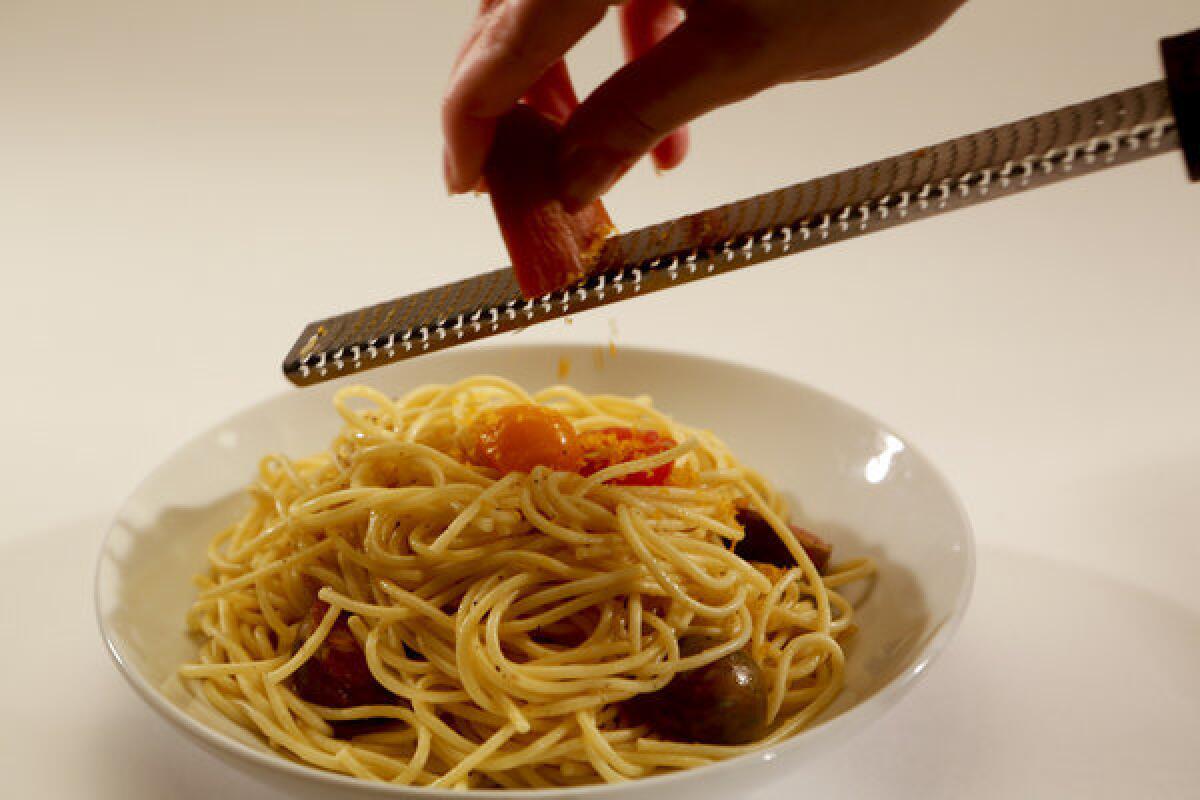<i>Bottarga</i>, a briny Mediterranean delicacy worth smuggling

Like cilantro or sea urchin, bottarga is a taste you either love or hate. I was hooked the first time I tasted spaghetti alla bottarga on the island of Sardinia in the Mediterranean. The al dente pasta dressed with fruity olive oil and dusted with amber-gold grated bottarga tasted like summer on a plate. And I loved the cured mullet roe’s sharp, briny funk.
Bottarga is hardly a new ingredient: It has been traded up and down the Mediterranean for thousands of years. But all of a sudden it’s been popping up on local menus, and home cooks no longer have to smuggle it home from Italy. There’s even a guy making it in Florida, of all places.
I’ve been stuffing my socks with vacuum-packed bottarga on every trip from Italy for years, never knowing when I’d have the chance to buy more again. It’s not exactly cheap, but it’s not the price of caviar or truffles either, more of a semi-affordable luxury. And the beauty is that it keeps — and keeps — so even if you shave off a little for a pasta dish and don’t get back to it for a month or two, the salted, cured roe will be just fine.
I can’t tell you how happy — no, the word is “safe” — I feel knowing that I have my piece of bottarga tucked away, ready to make spaghetti alla bottarga or a crostini topped with bottarga whenever I get the urge. This is my comfort food. Who’s to say you can’t adopt one later in life? Whenever I eat bottarga, I think of those turquoise Mediterranean seas and the protected lagoons of Cabras, where the very best bottarga di muggine is made.
Actually, bottarga comes in two varieties. Bottarga di muggine made from the roe of cefalo, or gray mullet, is a specialty of Sardinia, Bottarga di tonno hails from Sicily (and in some cases Calabria), where tuna has been fished (and overfished) for centuries.
I knew I was crazy about bottarga di muggine, but tuna? Not so much. That is until a friend insisted on taking me to an eccentric seafood restaurant in Italy where we ate everything raw and still wriggling. I remember the sweet, sticky shrimp and a ripe, juicy and very red tomato, halved and topped with a slice of tuna bottarga the size of a credit card. That extraordinary combination — silky tomato against the deep salt funk of the bottarga — changed my mind.
Bottarga is sold either vacuum-packed or sealed in beeswax. As long as it hasn’t been opened, it’s best if used within 15 months but will still be fine for two or three years. Bottarga is sensitive to ultraviolet light, so it is best stored in a dry and dark place.
To use it, open the packet and peel back the membrane of only as much as you think you’re going to use. If you plan to use it all in a few days, you can just leave it out. Otherwise, put it in a ziplock bag in the refrigerator. Some people don’t even do that, leaving it in a cool place, such as a wine cellar.
The best tool for grating bottarga di muggine is a really fine microplane. And don’t use too much pressure.
Because tuna bottarga is softer, it’s hard to grate without turning into a paste. The better use is to slice it very thinly with a knife after cutting away the outside skin.
The beauty is that once opened, bottarga will keep almost forever in the refrigerator. It’s always there, ready to make an impromptu appetizer or pasta dish.
Ten years ago, it was difficult to find, but now that bottarga is having a moment, it’s much more available. I guess I won’t have to be hiding it in my socks when going through customs anymore — leaving more room for wild boar salami or an obscure cheese.
More to Read
Eat your way across L.A.
Get our weekly Tasting Notes newsletter for reviews, news and more.
You may occasionally receive promotional content from the Los Angeles Times.






